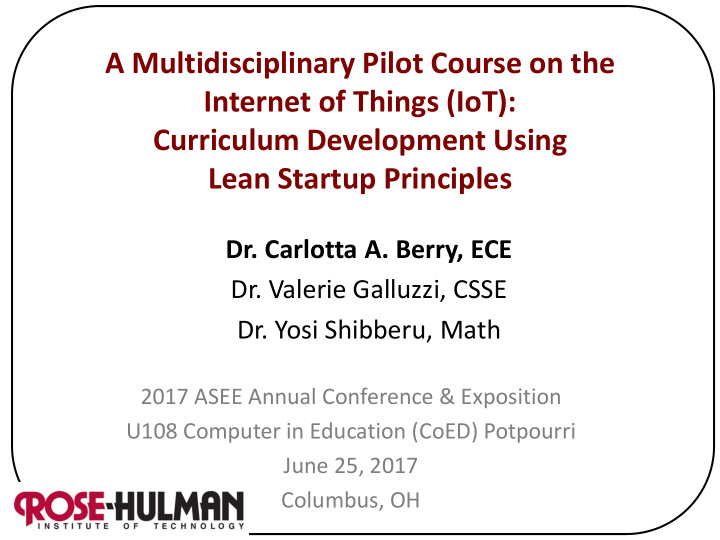



A Multidisciplinary Pilot Course on the Internet of Things (IoT): Curriculum Development Using Lean Startup Principles Dr. Carlotta A. Berry, ECE Dr. Valerie Galluzzi, CSSE Dr. Yosi Shibberu, Math 2017 ASEE Annual Conference & Exposition U108 Computer in Education (CoED) Potpourri June 25, 2017 Columbus, OH
Introduction • What is IoT? • Large Growth • Challenges
IoT Course • project-based • Pilot • 8 students • Just-in-time problem-based learning • Student Recreation Center Treadmills
Course Challenges • When? Where? Context? • Multidisciplinary • Breadth versus depth • Requires a holistic view • Varied implementations • No standard learning objectives or course outcomes
Lean Startup • Weeks from inception to deployment • Students involved in early stage • Just In Time teaching • Minimum Viable Product (MVP)
Pilot Course • Course content versus student learning • Top-down, linear versus dynamic and unstructured • More creative • Make connections • Ask more questions
Pilot Course • Off the shelf hardware • Multidisciplinary • Novel content • Machine learning • Distributed computing • Multiple sensor • Sensor to sensor communication • Single project
Project Characteristics • Wireless transfer of data • Limited power • Large amounts of data • Machine Learning • Feature Selection • Signal Processing • Distributed Information
Project • Put Shimmer 3 IMU sensors with gyroscope on treadmills • 4 mtgs per week • Hardware (ECE) – Radio communication – Compressed sensing • Software (Math, CS) – Bluetooth communication – Machine Learning
Results • Data features – mean, • Able to classify maximum, standard treadmill activity as no deviation of activity, running or accelerometer, walking at 98% positive magnetometer, rate frequency and power • This was done in real spectra time on the treadmill • Created machine learning classifiers • Used cross-validation
Challenges • Importance of Power consumption • Challenging creating a ground truth data set • Danger of overfitting data • Assessing technical mastery may be difficult
Conclusions • Team teaching greatly • Literature review reduced course burden • Documentation of team • Create more strategic communications framework for • Add data and device expectations security • Submit weekly progress • Invited lectures memos • Voice of the customer • Time log of activities
Questions www.rose-hulman.edu/~berry123 berry123@rose-hulman.edu
Recommend
More recommend